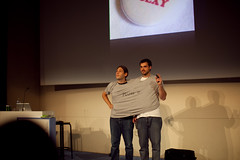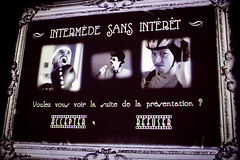FUD again – Flash vs. HTML(5) – yes, open things are easy to retrieve
Wednesday, January 26th, 2011I am very disappointed with a post released today by Serge Jespers, Adobe Evangelist entitled Stealing content was never easier than with HTML5.
I am mostly disappointed by the headline which I hope is there for link-baiting and Google juice. In other words, really cheap and lame propaganda.
The post has a good intention: there is a problem with open media standards in HTML5 that there is no way to protect premium content from being downloaded. There is no DRM, there is no encryption or watermarking. If we want premium content publishers on the bandwagon, then we need to think about that. Posts like this with this headline make it hard for us to even reach people to talk about the options. It is FUD and Adobe as a company that claims to support HTML5 should know better.
Right now, I do tell people who are paranoid about their content to use Flash as it has a certain degree of protection against simple downloading. If Adobe’s official spokespeople keep spouting messages like this, I will move to tell them to use Silverlight.
The argument that it is easy to download video in HTML5 as you can see it in the source is like saying that it is easy to steal newspapers in train stations as they are easy to reach. It is invalid – that you can steal it is not the issue here, the issue is what you do with the paper. Do you take it from the stand and go and pay it without looking at it? Do you read it on the spot and then put it back? Do you leave with it without paying? Or do you check the headlines and when you are intrigued you go and pay for it? Do you take the paper, go to a copier, copy it and then try to sell the copies? Fact is – it is dead easy to get the paper, the same way it is dead easy to get a video online.
I find myself many a time downloading YouTube videos as I am on the go a lot. Being on the go (and considering data plans and roaming) means I have no connection, or I have a flaky connection that downloads the movie to minute 3 and then stalls while the fan of my laptop spins. Instead, at home when I got my fat connection I download some talks and screencasts and watch them offline using VLC. Then I delete them – or I blog about them first linking to YouTube and advertise them that way.
To download these extremely well protected Flash movies I use one of the dozens of services, browser extensions or apps out there.
Allowing people to download a movie means you get a bigger audience. If you make people jump through hoops to watch a movie or make them watch a 5 minute ad for a 10 second film you shouldn’t be surprised if they use P2P filesharing or Hotfile, Rapidshare, Fileserve, Megaupload and dozens of other services to download the movie in 10 seconds and then watch it at their leisure.
Recognise something? The mere fact that there are thousands of downloaders for YouTube and paid for hosting services that offer easy to download pirated copies means that there is a demand for that feature. A feature that would make me damn happy to have on YouTube and I would pay for it.
So instead of demonising HTML5 as the backdoor that will allow evil doers to steal your goodies maybe it is time for premium content providers to open up to the needs of web users, and find a way to publish previews of content and the full content for subscribed users. There are ways to make money and share your products – but not if you spend most of your time and money on things that seemingly give you protection but in reality are just a glass shield.

